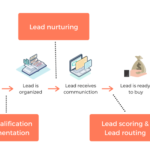25 Effective Strategies to Boost E-commerce Conversion Rates

So, you have decided to increase e-commerce conversion rates for your business but don’t know where to start.
Customers these days have a plethora of options available to them, so they take a little longer to purchase things from a particular website.
In this case, e-commerce businesses must rev up their sales game to improve conversion rates.
The average conversion rate for e-commerce sites across all sectors ranges from 2% to 4%.
Here is a closer look at a few ways to increase e-commerce conversion rates and ensure customer satisfaction.
E-commerce Conversion Rates – Brief Introduction
E-commerce conversion rates are among the most critical metrics for any e–e-commerce business.
Visitor turnover rate is the percentage of visitors who have taken the action to complete a purchase compared to the number of visitors on the website.
A high conversion rate ensures that your e-commerce store is user-optimized, while a low rate indicates issues keeping customers from making purchases.
The conversion rates of the beauty industry are among the highest of all the other sectors. According to Statista, the beauty industry holds a 2.7 conversion rate.
While purchases are the highest form of conversion for an e-commerce business, other actions also act as a conversion factor for a business. These factors include:
- Completing a lead generation form
- Downloading a guide/e-book
- Contacting customer service
- Subscribing to a newsletter
- Engaging with the business in any way.
Smartphones account for over 70% of retail website visits worldwide (Statista, 2024).
Calculating E-commerce Conversion Rates
To calculate the e-commerce conversion rate, start by examining the number of visitors making a purchase dividing it by the number of visitors on the website, and multiplying it by 100.
So the formula for the conversion rate would look something like this:
(Total visitors who purchase / total website visitors) x 100 = e-commerce conversion rate
For Example, Let’s say your website has 300,000 unique visitors in a month, but only 20,000 of them make a purchase. In this case, your conversion rate would be the following:
(20,000 / 300,000) x 100 = 6.6% conversion rate.
Low-cost items like food and apparel tend to have higher conversion rates, while expensive items like luxury items and travel have lower conversion rates.
Ways to Increase E-commerce Conversion Rates
Now, to the best part. Once you’ve calculated your e-commerce rate, you might realize it needs a little bump.
High-quality shopping experiences that include all the information that a consumer would need to make an intelligent decision and complete a purchase are crucial to improving e-commerce conversion rates.
Here are 25 great ways to increase e-commerce conversion rates.
- Start Small
Before making any significant changes to your website, start small and make subtle changes like changes in CTAs and designs to see where the problems lie.
Look at the products that sell well, focus on what sets them apart, and research the design choices or the CTAs that have made them different.
This will save you from any significant expenditures of a whole revamp and give you new ideas on making changes that appeal to your visitors.
- Keep Your Advertisement Copy Uniform
Misleading and misaligned advertisement copies along your marketing platforms can lead to increased bounce rates and customer confusion.
This is why it is crucial to ensure that all your advertisements have a uniform copy along all the marketing platforms, so whichever platform these customers use they have the same idea in mind.
More than one in three marketing leaders cite conversion rates as a top KPI that they prioritize tracking (HubSpot State of Marketing Report, 2023).
- Offer Coupon Codes
Almost 50% of American consumers discover coupons through emails from brands they subscribe to or through online searches.
Customers are more than likely to purchase if they are offered coupon codes. Promoting coupon codes through emails, social media, and more can help nudge consumers into making a purchase from the brand.
- Make Your Site Easy to Navigate
An intuitive and easy-to-navigate website makes it easier for customers to use and make purchases.
Make the customer scanning process easier with menu and page optimizations.
Place the most essential categories at the top of the menu list, while the others can be categorized according to their importance.
34% of mobile eCommerce sites do not offer “thematic” product browsing, making it difficult for users to find what they want, so categorizing items as per their themes can be helpful.
- Remove Distractions
Closer customer handoffs can be achieved if the clutter is removed from your website so that potential customers are not distracted by what they see. ConversionXL did a study that showed you can increase your conversion rates by 11.4% just by simplifying the design of your site and removing the unnecessary elements on the page.
- Decrease Load Time
Website speed is crucial. Slow-loading sites can cost you your conversion rate. According to a Google survey, 53 percent of mobile users will abandon a site that takes more than 3 seconds to load. Page load times affect both conversions and can positively affect customer’s shopping experience.
7. Offer Free Returns
If shoppers know they can quickly return an item, they are more likely to purchase. A recent study by Narvar found that 96 percent of people are likely to shop with a retailer again if the return process is easy.
- Conduct A/B Testing
Through A/B testing, you experiment with different versions of your site to determine which one has increased conversion.
70% of marketers believe that A/B testing is essential to boost conversion rates.
- Mobile Optimization
With over 50% of global e-commerce traffic coming from mobile devices and the average mobile conversion rate is less than desktop, there is still a lot to be done.
Most marketers report that mobile devices were responsible for more than half of their annual traffic.
This is why it is important to ensure that your website is optimized for mobile users. Make the content fit the mobile screens with ease so there is a minimum requirement for extra movement.
10. Introduce UGC
Real customer experiences can be trusted more than branded marketing. Reviews, testimonials, and user photos create user-generated content that helps build authenticity and social proof.
11. Add UGC Visuals
Visuals like customer photos or videos enrich the shopping experience. Yotpo research observed a rise in conversion rates for UGC visuals because we trust things that are in real life; hence, websites with images capture that trust.
- Offer Free Shipping
Shipping cost is the main reason people abandon their carts. Unfortunately, 55% of shoppers abandon their carts because of high shipping fees.
Mobile devices are responsible for 76.61% of cart abandonments.
Free shipping (sitewide or at a particular total order) decreases cart abandonment and increases conversions.
- Get Customer Feedback
Surveys or live chat with customers can provide you with feedback on friction points in customer experience. As businesses are more equipped to make improvements, 67% of businesses that utilize customer feedback saw tremendous growth.
- Be On Top of Follow Ups
Businesses lose many customers, many of whom leave without even completing their purchase. Important follow-up emails, including abandoned cart reminders, can recover lost sales. Abandoned cart emails have an average conversion rate of 18.64%.
- Provide Better Customer Service
Great customer service goes a long way toward winning a sale. According to Helpscout, 93% of customers would also be more likely to return to buy from a company with excellent service.
- Shoot Small
Business messaging becomes more personalized and relevant when focusing on specific niches or smaller customer segments. For example, McKinsey revealed that personalization can achieve 5–8x the ROI on marketing spend and increase sales by 10 percent or more.
- Use High-Quality Images
Clear, high-resolution images boost customer confidence when shopping online. An Innovative Imaging research found that 67% of consumers think the image quality is “paramount” when purchasing.
- Promote Benefits
Don’t sell the features—sell the benefits. Emphasizing that a product helps the customer’s life resonate better. According to Neil Patel, focusing on benefits over features can increase conversions by 47%.
- Use Social Media
Traffic and engaging with potential buyers on social media platforms like Instagram and Facebook are very important.
Social media is the most preferred product discovery platform for consumers aged 18 to 44, and most are likely to purchase directly from social media platforms.
- Optimize Your FAQ Page
A good FAQ page answers questions that could otherwise dissuade a customer from buying. According to the Search Engine Journal, FAQ sections optimized for answering some common objections can improve conversions by up to 10%.
- Secure Your Site
E-commerce sites must ensure security. According to SpinxDigital, 61% of consumers will not buy from a site if they think they can’t trust it. Display trust badges, use SSL certificates, and assure customers that their data is safe.
- Create FOMO
This urge creates an improvising sense of urgency, so we may need to act fast. FOMO tactics, such as countdown timers or limited stock alerts, can increase conversion rates by up to 9%.
- Send Abandoned Cart Reminders
According to the Baymard Institute, cart abandonment is common in e-commerce, with an average rate of 70.19% globally. Cart abandonment emails can be sent automatically to recover 15% of lost sales by reminding customers to finish their purchases.
- Reduce Form Feilds
Reduce the number of form fields customers are instructed to fill out, making your checkout process as simple as possible.
Simply reducing the form fields from 4 to 3 can increase conversion rates by up to 50%.
Reducing the number of form fields to 10 or under increases conversions by 120%.
- Retarget Visitors
Retargeting ads will help you remind visitors of products they viewed but didn’t purchase. Retargeted ads on Facebook have a 76% higher click-through rate than regular display ads, meaning you have more chances of generating conversions.
Studies also found that 70% of consumers will likely convert with retargeting.
Key Takeaways
To increase e-commerce conversion rates, you need to test and optimize continuously. This includes small things like simplifying website navigation, offering free shipping, and removing distractions from users’ intent.
Pair these tactics with punchy SEO techniques such as A/B testing, user-generated content, and retargeting to boost conversions and increase revenue.
By making the shopping experience more straightforward, personalized, and customer-centric, you can turn more visitors into loyal customers.
FAQs
What is a good conversion rate for e-commerce?
Typically, a reasonable e-commerce conversion rate lies between 2-5%. Conversion rates can differ significantly based on industry, product type, target audience, and location, but there is no doubt that the improved tracking is helping. Conversion rates can be higher (upwards of 10% or even more) on some high-performing e-commerce websites or niche markets than others.
What are the conversion rate KPIs for e-commerce?
Key Performance Indicators (KPIs) that measure e-commerce conversion rates include:
- Overall Conversion Rate
- Cart Abandonment Rate
- Checkout Abandonment Rate
- Average Order Value (AOV)
- Customer Lifetime Value (CLV)
- Repeat Purchase Rate
- Mobile Conversion Rate
- Email Conversion Rate
- Landing Page Conversion Rate
What is Amazon’s conversion rate?
Not only is Amazon’s conversion rate much higher than the e-commerce average, but it is also much higher than the conversion rate achieved by 94% of retailers. According to estimates, Amazon’s conversion rate for its Prime members is 74%, while non-Prime members convert at a rate of 13% or less. This is because Amazon’s shopping experience is well-optimized, and customers trust them.
What are the factors behind low conversion rates?
Several factors can contribute to low conversion rates in e-commerce, including:
- Poor Website User Experience (UX)
- Unclear Value Proposition
- High Shipping Costs
- Complicated Checkout Process
- Lack of Trust or Credibility
- Limited Payment Options
- Insufficient Product Information
- Poor Customer Support
- No social proof or reviews
- Too little marketing alignment






